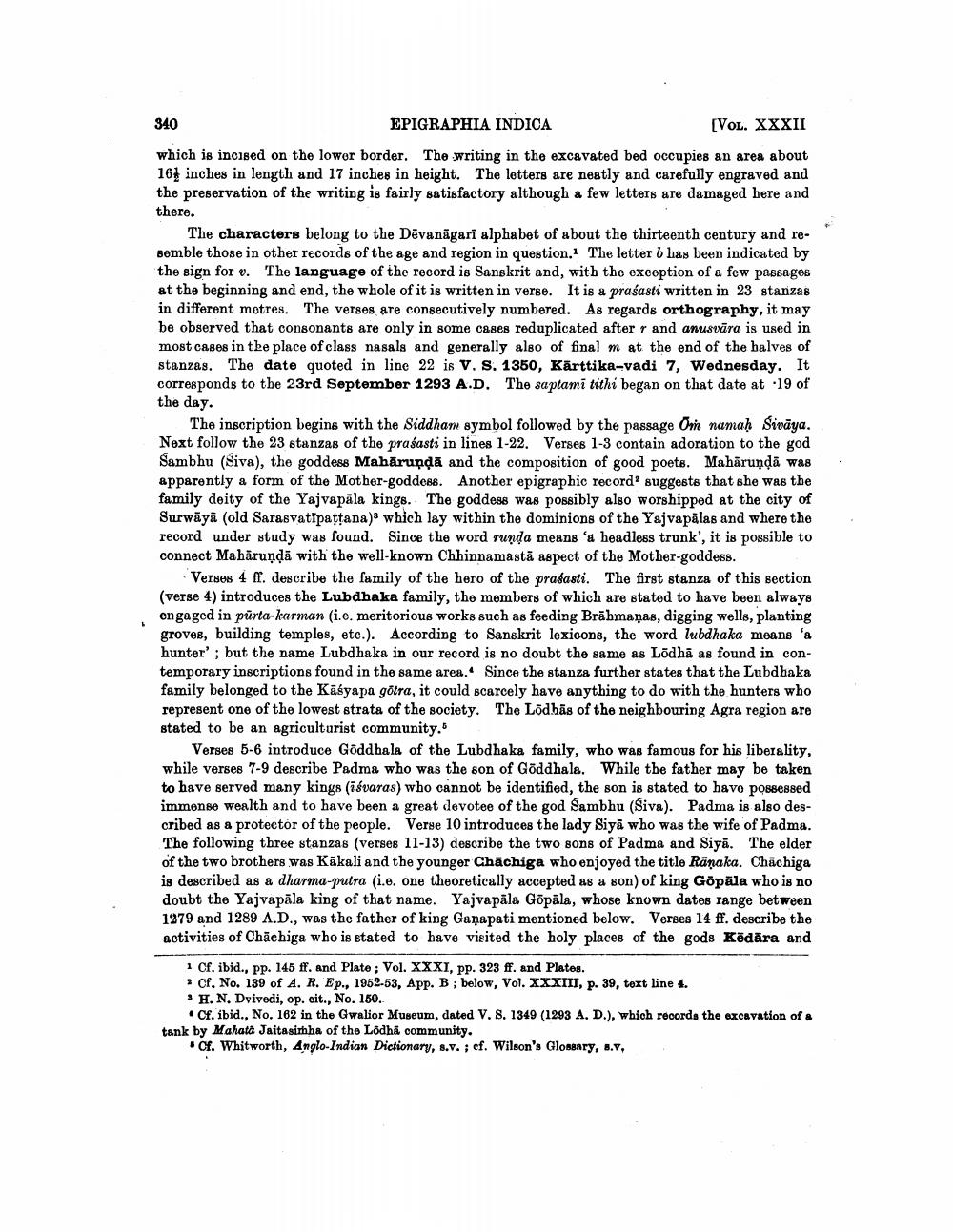________________
340 EPIGRAPHIA INDICA
[VOL. XXXII which is incised on the lower border. The writing in the excavated bed occupies an area about 164 inches in length and 17 inches in height. The letters are neatly and carefully engraved and the preservation of the writing is fairly satisfactory although a few letters are damaged here and there.
The characters belong to the Dāvanāgari alphabet of about the thirteenth century and resemble those in other records of the age and region in question. The letter b has been indicated by the sign for e. The language of the record is Sanskrit and, with the exception of a few passages at the beginning and end, the whole of it is written in verse. It is a prasasti written in 23 stanzas in different motres. The verses are consecutively numbered. As regards orthography, it may be observed that consonants are only in some cases reduplicated after r and anusvāra is used in most cases in the place of class nasals and generally also of final m at the end of the balves of stanzas. The date quoted in line 22 is V. S. 1350, Kārttika-vadi 7, Wednesday. It corresponds to the 23rd September 1293 A.D. The saptami tithi began on that date at 19 of the day.
The inscription begins with the Siddham symbol followed by the passage Om namah Sivāya. Next follow the 23 stanzas of the prasasti in lines 1-22. Verses 1-3 contain adoration to the god Sambhu (Siva), the goddess Mahārupda and the composition of good poets. Mahāruņdā was apparently a form of the Mother-goddess. Another epigraphic record suggests that she was the family deity of the Yajvapāla kings. The goddess was possibly also worshipped at the city of Surwāyā (old Sarasvatipattana) which lay within the dominions of the Yajvapālas and where the record under study was found. Since the word runda means 'a headless trunk', it is possible to connect Mahārundā with the well-known Chhinnamastā aspect of the Mother-goddess.
Verses 4 ff. describe the family of the hero of the prasasti. The first stanza of this section (verse 4) introduces the Lubdhaka family, the members of which are stated to have been always engaged in pürta-karman (i.e. meritorious works such as feeding Brāhmaṇas, digging wells, planting groves, building temples, etc.). According to Sanskrit lexicons, the word lubdhaka means 'a hunter'; but the name Lubdhaka in our record is no doubt the same as Lõdhā as found in contemporary inscriptions found in the same area. Since the stanza further states that the Lubdhaka family belonged to the Kāsyapa götra, it could scarcely have anything to do with the hunters who represent one of the lowest strata of the society. The Lõdhās of the neighbouring Agra region are stated to be an agriculturist community."
Verses 5-6 introduce Goddhala of the Lubdhaka family, who was famous for his liberality, while verses 7-9 describe Padma who was the son of Goddhala. While the father may be taken to have served many kings (īśvaras) who cannot be identified, the son is stated to have possessed immense wealth and to have been a great devotee of the god Sambhu (Siva). Padma is also described as a protector of the people. Verse 10 introduces the lady Siyā who was the wife of Padma. The following three stanzas (verses 11-13) describe the two sons of Padma and Siyā. The elder of the two brothers was Kākali and the younger Chāchiga who enjoyed the title Ränaka. Chichiga is described as a dharma-putra (i.e, one theoretically accepted as a son) of king Göpäla who is no doubt the Yajvapāla king of that name. Yajvapāla Gõpāla, whose known dates range between 1279 and 1289 A.D., was the father of king Ganapati mentioned below. Verses 14 ff. describe the activities of Chächiga who is stated to have visited the holy places of the gods Kēdāra and
i Cf. ibid., pp. 145 ff. And Plate ; Vol. XXXI, pp. 323 ff. and Plates.
Of, No. 139 of A. R. Ep., 1952-53, App. B; below, Vol. XXXIII, p. 39, text line 4. * H. N. Dvivedi, op. cit., No. 150.
• Cf. ibid., No. 162 in the Gwalior Museum, dated V. S. 1349 (1293 A, D.), which records the excavation of a tank by Mahata Jaitasimha of the Lodhã community.
Of. Whitworth, Anglo-Indian Dictionary, s.v. ; cf. Wilson's Glossary, s.v.




